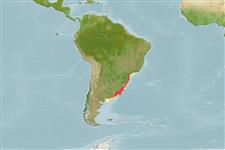>
Pleuronectiformes (Flatfishes) >
Paralichthyidae (Large-tooth flounders)
Etymology: Paralichthys: Greek, para = the side of + Greek, ichthys = fish + Greek, suffix, oides = similar to (Ref. 45335).
Eponymy: Alcide Charles Victor Dessalines d’Orbigny (1802–1857) was a traveller, collector, illustrator and naturalist. [...] (Ref. 128868), visit book page.
More on author: Valenciennes.
Environment: milieu / climate zone / depth range / distribution range
ນິເວດວິທະຍາ
ສັດທະເລ; ນ້ຳກ່ອຍ ອາໄສຢູ່ໃກ້ໜ້າດິນໃຕ້ພື້ນທ້ອງນ້ຳ; ປາທີ່ມີການເຄື່ອນຍ້າຍໃນສະເພາະມາະຫາສະມຸດ; ລະດັບຄວາມເລິກ 1 - 45 m (Ref. 43588), usually 1 - 20 m (Ref. 43588). Subtropical; 23°S - 41°S
Southwest Atlantic: Rio de Janeiro, Brazil to at least Mar de la Plata, Argentina.
Length at first maturity / ຂະໜາດ / ນ້ຳໜັກ / Age
Maturity: Lm ?, range 39 - ? cm
Max length : 83.0 cm TL ຕົວຜູ້/ບໍ່ມີເພດ; (Ref. 127691); common length : 32.0 cm SL ຕົວຜູ້/ບໍ່ມີເພດ; (Ref. 43588); ອາຍຸສູງສຸດທີ່ເຄຍລາຍງານມາ: 11 ປີ (Ref. 127691)
ຄີ (ໜາມ)ແຂງຢູ່ຫຼັງປາ (ທັງໝົດ) : 0; ຄີຫຼັງຂອງປາ (ຄີອ່ອນ) (ທັງໝົດ) : 71 - 77; ຄີ(ໜາມ) ແຂງຢູ່ຄີກົ້ນປາ
ກຸ່ມປາກະດູກແຂງ
ຄວາມຖີ່ຂອງກຸ່ມຖ່າຍທອດພັນ
ປາທີ່ມີການເຄື່ອນຍ້າຍຈາກທະເລໄປຫານ້ຳຈືດ ແລະນ້ຳຈືດຫາທະເລ
ປາທີ່ມີການເຄື່ອນຍ້າຍຈາກທະເລແລະໄປໄຂ່ຢູ່ນ້ຳຈືດ
ຄີກົ້ນຂອງປາ
ສັດທີ່ມີກະດູກສັນຫັຼງ
ການຖ່າຍທອດທາງກຳມະພັນຈາກພໍ່ແມ່ຫາລູກ: 0; ຄີກົ້ນຂອງປາ: 52 - 59; ສັດທີ່ມີກະດູກສັນຫຼັງ: 35 - 36. Body shape oval, with the greatest breadth 2.5 times in length. Eyes are on the left side, close together, and equally in advance. Teeth are in a single series, sharply pointed. Dorsal fin origin aligned with eyes. Lateral line arched over the pectoral fin. Eye side of the body slightly rough, with finely ciliated scales (Ref. 3157).
Populations are found in shallow coastal marine waters (Ref. 127691). They enter coastal lagoons (Ref. 36453). Nursery grounds are found in estuaries, coastal lagoons and brackish surf waters (Ref. 127691). Adults feed on pelagic and benthic species of crustaceans (penaeids and brachyurans), and lesser important fishes (Ref. 43588). Juveniles mainly feed on plolychaetes (Ref. 127691).
Distinct pairing (Ref. 205).
Figueiredo, J.L. and N.A. Menezes, 2000. Manual de peixes marinhos do sudeste do Brasil. VI.Teleostei (5). Museu de Zoologia, Universidade de São Paulo. Brazil. 116 p. (Ref. 36453)
IUCN Red List Status (Ref. 130435: Version 2024-2)
Threat to humans
Harmless
Human uses
ການປະມົງ: ເປັນສີນຄ້າ
ເຄື່ອງມື
Special reports
Download XML
ແຫຼ່ງອີນເຕີເນັດ
Estimates based on models
Preferred temperature (Ref.
123201): 13.4 - 22.8, mean 16.1 °C (based on 118 cells).
Phylogenetic diversity index (Ref.
82804): PD
50 = 0.5000 [Uniqueness, from 0.5 = low to 2.0 = high].
Bayesian length-weight: a=0.00676 (0.00432 - 0.01057), b=3.11 (2.98 - 3.24), in cm total length, based on LWR estimates for this species & Genus-body shape (Ref.
93245).
ຊັ້ນເຂດຮ້ອນ (Ref.
69278): 3.5 ±0.54 se; based on food items.
ຄວາມຢືດຢຸ່ນ (Ref.
120179): ຕຳ່, ປະຊາກອນຕຳ່ສຸດທີ່ໃຊ້ເວລາສອງເທົ່າ 4.5 - 14 ປີ (K = 0.12).
Fishing Vulnerability (Ref.
59153): Moderate to high vulnerability (53 of 100).
Nutrients (Ref.
124155): Calcium = 64.7 [29.4, 115.1] mg/100g; Iron = 0.905 [0.455, 1.626] mg/100g; Protein = 16.3 [13.9, 19.6] %; Omega3 = 0.173 [0.086, 0.325] g/100g; Selenium = 24.3 [11.4, 54.1] μg/100g; VitaminA = 11.9 [3.3, 46.1] μg/100g; Zinc = 0.681 [0.446, 1.021] mg/100g (wet weight);
